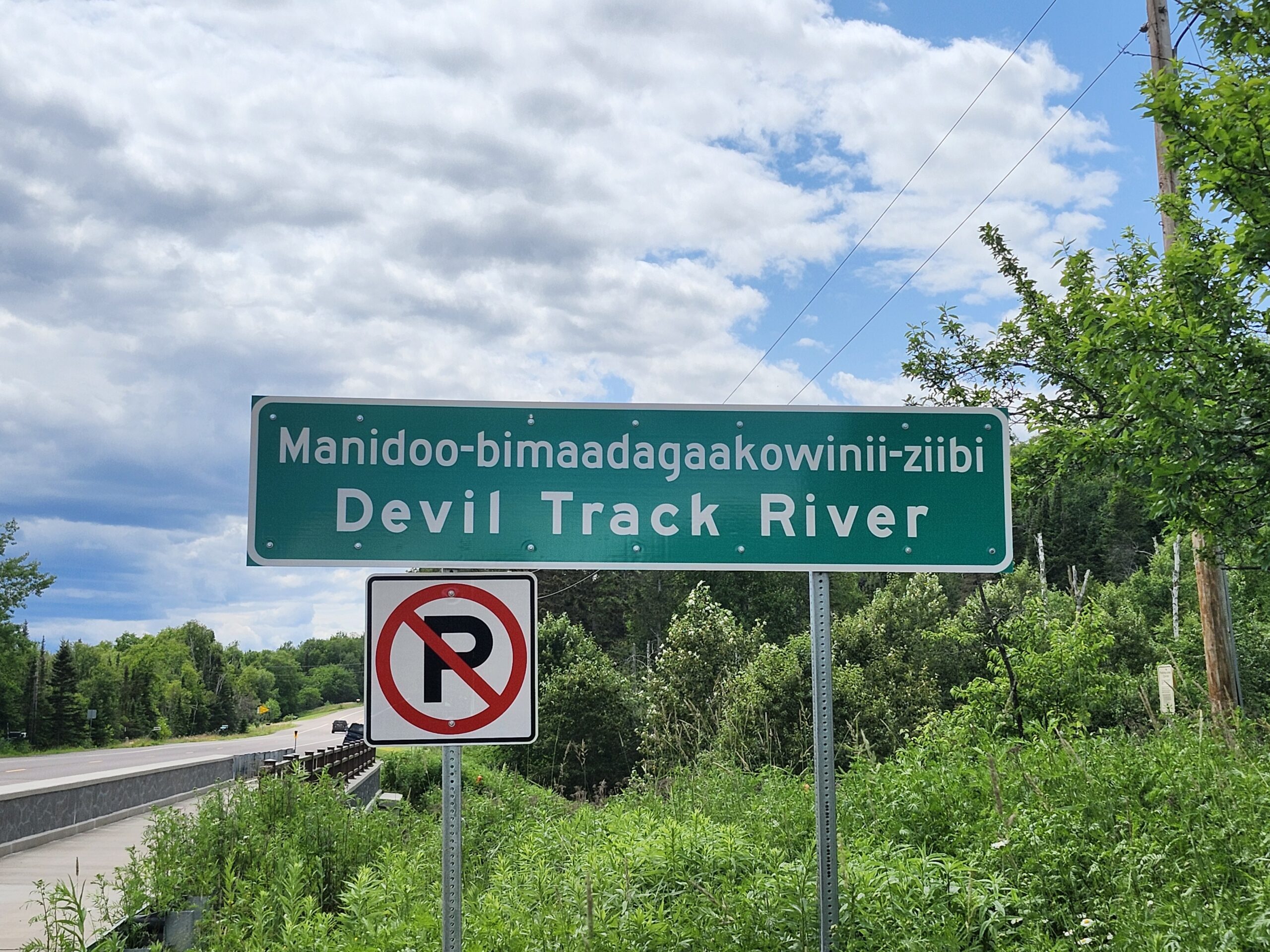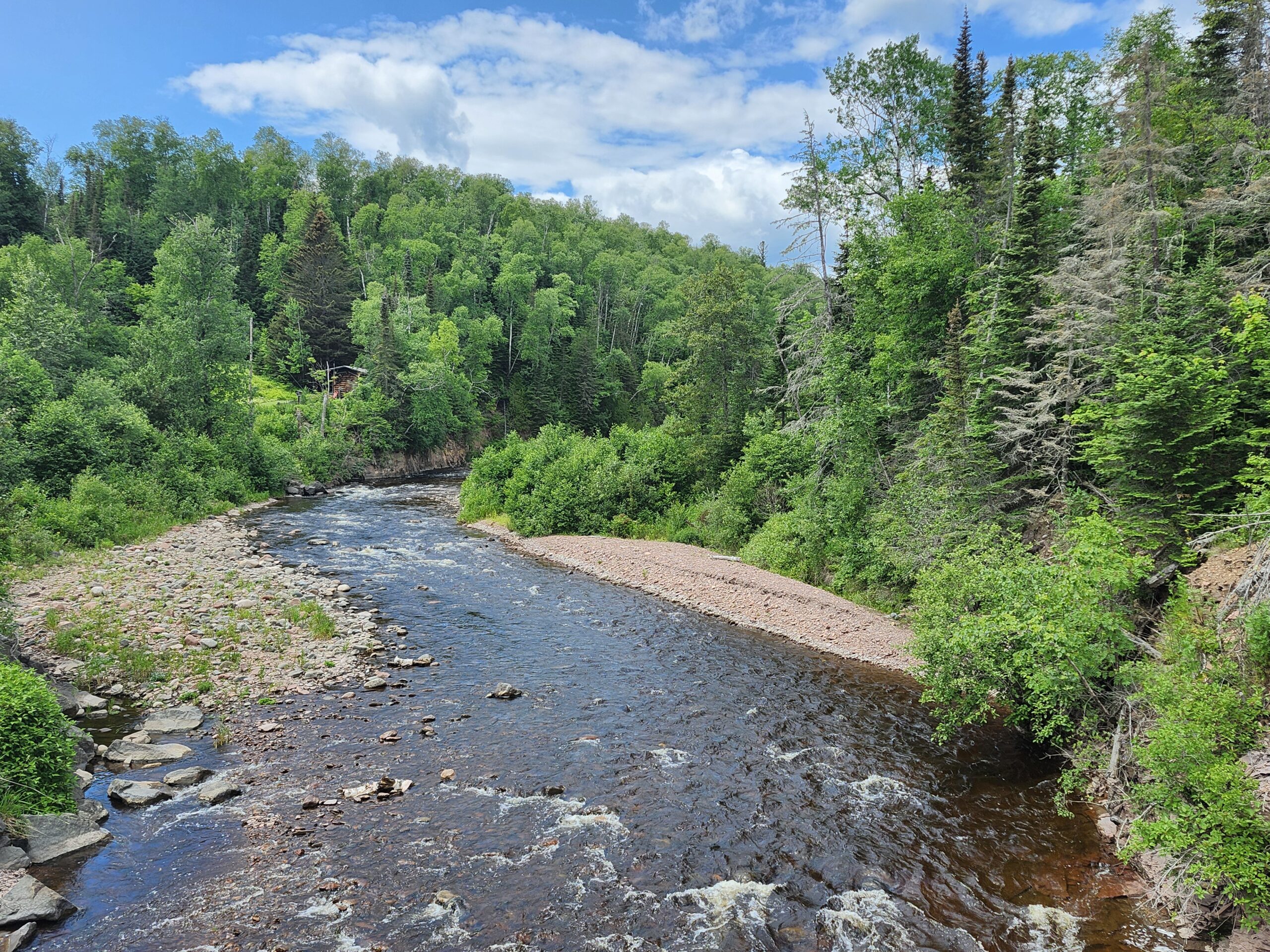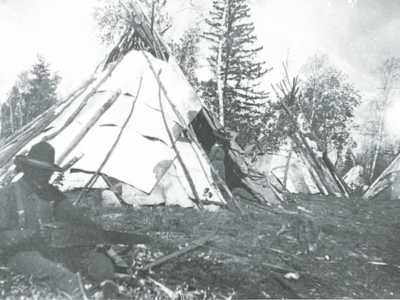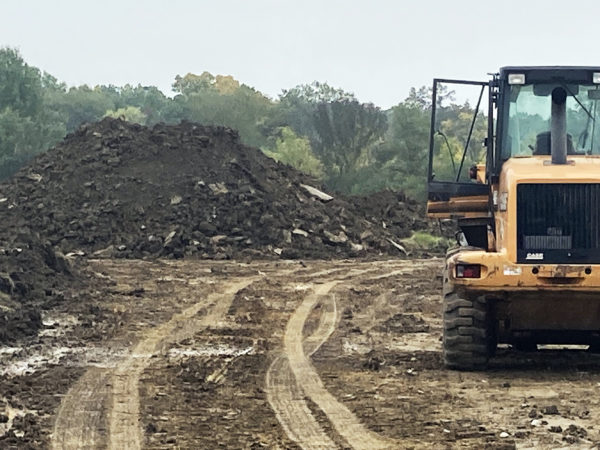
“Nibi Chronicles,” a monthly Great Lakes Now feature, is written by Staci Lola Drouillard. A Grand Portage Ojibwe direct descendant, she lives in Grand Marais on Minnesota’s North Shore of Lake Superior. Her nonfiction books “Walking the Old Road: A People’s History of Chippewa City and the Grand Marais Anishinaabe” and “Seven Aunts” were published 2019 and 2022, and the children’s story “A Family Tree” in 2024. “Nibi” is a word for water in Ojibwemowin, and these features explore the intersection of Indigenous history and culture in the modern-day Great Lakes region.
Spirits going along on the ice river — Manidoo-bimaadagaakowinii-ziibi. That’s the Ojibwe name for a popular trout stream that outlets into Lake Superior between Gichi Onigaming (Grand Portage) and Kichi Bitobig (Grand Marais). The river tumbles downstream through steep canyons before emptying into the deep water of Gichigamiing. In the spring, when I was a little girl, my dad would take me along on his evening fishing excursions, hoping to land a salmon or steelhead trout at the mouth of the river.
I grew up understanding that the English version of the name — Devil’s Track River, was derived from a man named Sam Zimmerman, who was married to my great-aunt Josephine (née Drouillard) Zimmerman. Sam had a peg-leg, walked with a cane, and one winter, old Sam Zimmerman was out for a walk on an inland lake. The area Ojibwe people, upon seeing these strange, bi-furcated tracks in the snow, named the lake and the associated river “Devil’s Track.” This is the origin story that you’ll find in some local history books and shared by old-timers. But it turns out that the actual origin of the name goes back even further than that.
Evidence that the name preceded non-Indigenous settlers on the North Shore emerged on the pages of a map created by the early explorer David Dale Owen in 1848 — six years before the Treaty of 1854 allowed for white settlement on the North Shore. The emergence of the map and the shape-shifting of names in Ojibwe country is something that I wrote about in a previous Nibi Chronicles column. To summarize; anytime you see reference to the “devil” within a place name, it’s likely that the name was converted from a viewpoint of reverence and positive association (Spirits going along on the ice), to one of fear and devilishness, having a negative viewpoint or “bad” association. This was done entirely on purpose, and was used to strip Indigenous people of our spiritually important places, language and culture.
Thanks to a small group of Ojibwe language speakers and historians, the information on the 1848 map has now been translated and converted into an online language tool that includes Ojibwe names and corresponding audio pronunciations for 22 river names. This ranges from Beaver Bay to Gaa-ministigweyaag (Place that Flows to Islands River), also known as the Kaministiquia River in Thunder Bay, Ontario. The “Rivers of the North Shore” language project also includes many Ojibwe names for lakes, towns and places of significance previously undocumented by the written, historical record.
Part of the effort to bring the original names home was the installation of new signs along Highway 61 and elsewhere, bringing together the English version, along with the Ojibwe version for the first time. This was a point of great pride and excitement for those who believe that history and cultural connection is important to understanding the places where we live.
Honoring the deep history of the Great Lakes

The “Rivers of the North Shore” language project also includes many Ojibwe names for lakes, towns and places of significance previously undocumented by the written, historical record. (Photo Credit: Staci Lola Drouillard)
I first studied Ojibwemowin (part of the Algonquian or Algic language family) in college with Professor Collins Oakgrove-iban from Red Lake, and currently attend an Ojibwe language round table led by Ricky DeFoe from Fond du Lac and Dené Sinclair from Peguis First Nation, Manitoba. As a humble student of Ojibwemowin, seeing these familiar places adorned with the descriptive names given to them by our ancestors carries a deep sense of pride and a reminder of belonging. With each name, there is the added benefit of story and history telling — something that is invaluable to the human history of the North Shore.
That was until the news got picked up by some big media outlets and my feeling of triumph was clouded by a shocking level of ignorant comments on social media and even on our local community page.
“Well, I know where to go if I need to buy a vowel,” said one amused commenter.
“I like the idea, but IMO they should use a simpler, user-friendly version without the huge unpronounceable words that even most Indians [sic] don’t understand.”
One particularly hurtful comment on a Minnesota Public Radio (MPR) story suggested, “might as well bring Latin back as well. At least it has some value to people.”
What is more valuable than learning the deep history of a place and being welcomed into a cultural worldview that is the opposite of homogenous? How does one measure the inherent value of a name that truly honors the natural world? A place that continues to gift human and animal communities with a rich ecosystem to live in, fresh water, good fishing in the spring and the generous spirit of the original people, who graced it with spiritual significance and a literal description of its storied past.
There were also plenty of racist comments that went beyond ignorance and into the realm of cruelty and hatefulness toward Indigenous people and languages. It seems that some people view the re-homing of Indigenous names and the unveiling of culturally and historically significant signs, to be a threat, even if they’re just passing by at 65 miles-per-hour.
On that same MPR thread a few people proclaimed that “English is the official language of the United States,” trying to assert the false claim that there is an “official” language requirement in our country. There isn’t. And in fact, census data confirms that there are over 350 different languages spoken in the United States — Anishinaabemowin (the human language spoken by Anishinaabe/Ojibwe) being one of the originals.
So, in my view the new signs don’t go far enough. To avoid any further confusion about the descriptive nature of Ojibwemowin, I would hope that any future signage will include the full translation, as well as the converted English name and the Anglicized version, so that people can still find it on Google Maps — at least for now. Let’s break down how it could look:
Manidoo-bimaadagaakowinii-ziibi
Spirits going along on the ice river
Devil’s Track River
Our Ojibwe teacher Ricky DeFoe teaches us that the carrier of Ojibwemowin is Aginjibagesi (the goldfinch) and that yellow is the spiritual color associated with Anishinaabemowin/Ojibwemowin. While absorbed in thought about this modern fight to be heard, seen and recognized on signs and elsewhere: two bright, yellow, male goldfinches became engaged in a vocal spat just outside the screen porch where I was writing this month’s column. A beautiful reminder that communication and languages come in many forms, and that the living world of Anishinaabe Aki (Anishinaabe/Ojibwe country) has plenty of room for a multitude of voices and ways of seeing.
And if you would like to pronounce some of the names mentioned, here is a pronunciation key. Please note that any mistakes are my own.
Manidoo-bimaadagaakowinii-ziibi (Ma ni doo-bih maah dah gaako wih nee zee bih)
Gaa-ministigweyaag (Gaah-mih ni stig way yaag)
Gichigamiing (Gih che guh meeng)
Mii’iw
Catch more news at Great Lakes Now:
A Symbol of Survival: Red Pine Peels and Ojibwe Canoe Factories
Nibi Chronicles: Krishna’s quest for ticks
Featured image: Thanks to a small group of Ojibwe language speakers and historians, the information on the 1848 map has now been translated and converted into an online language tool that includes Ojibwe names and corresponding audio pronunciations for 22 river names. (Photo Credit: Staci Lola Drouillard)




